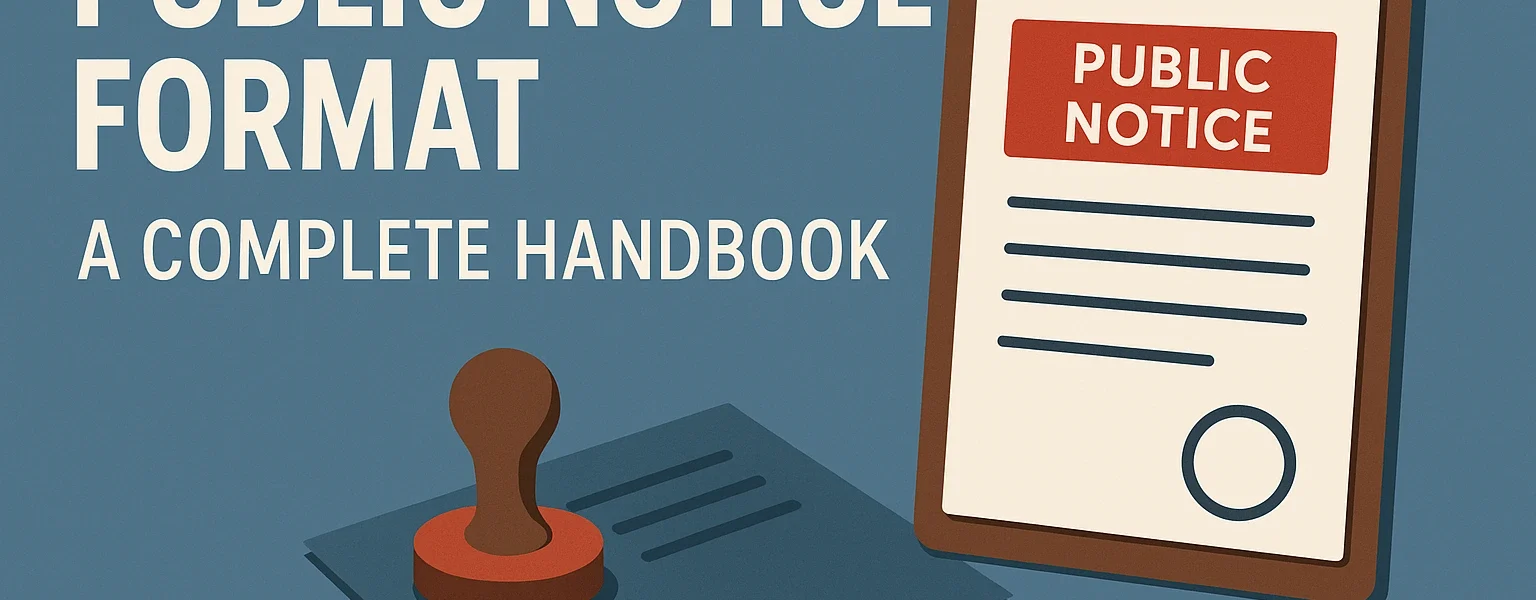- Homepage
- Public Notice
- Public Notice Format: A Complete Handbook
Public Notice Format: A Complete Handbook
Table of Contents
- Public Notice Format
- Purpose of a Public Notice
- Basic Structure of a Public Notice
- Types of Public Notices
- Legal Requirements for Public Notices
- Formatting Tips for Public Notices
- Digital vs. Print Notices
- Public Reaction and Action
- Common Mistakes in Drafting Public Notices
- Ethical Considerations in Public Notices
- Conclusion
- FAQs
Public Notice Format: A Complete Handbook
A public notice draws attention to significant matters such as legal negotiations, sales of properties, auctions, or other remarkable events. These comments are designed to be simple, precise, and clear so that important data can be conveyed effectively to the public. Depending on the kind of notice, public notice format are usually distributed publicly, shown offline, or made available on official websites.
The Purpose of a Public Notice
A public notice mainly draws attention to information that might impact people's responsibilities, rights, or general knowledge. It informs people about important issues, including legal processes, public hearings, property sales, or rule modifications. A public notice is vital for guaranteeing transparency and responsibility. It ensures that anyone affected by a notice has easy access to the data, whether it pertains to a name change, an auction, or a court decision.
Basic Structure of a Public Notice
A public notice should be written with a definite and methodical design. A common public notice ought to have these components:
- Issuing Organization :Clearly state the name of the company or individual in charge of the announcement. This assures the public that it is an official communication and adds legitimacy to it.
- Notice Title:The title must be brief and precise, capturing the aim of the notification. This enables readers to grasp the topic easily.
- Notation Date:The announcement's publication date is vital since it determines the timetable for the information and any pertinent deadlines or time-sensitive activities.
- Clear Heading:The core point of the notice should be emphasized in its title. Usually, it's a concise and straightforward statement highlighting the notice's key intent.
- Body of the Notice:The body of the notice should explain the situation in detail. It should cover essential aspects such as:
- What the notice covers (a property auction, legal action, etc.)
- Where the event or action, such as an auction or court hearing, will occur is noted.
- When it is happening (e.g., date and time of the event or deadline for responses).
- How the event or procedure will unfold (e.g., actions required from the public, such as filing objections or attending meetings).
- Signature and Name of the Author:The notice should name the person or company responsible for it. In official announcements, especially legal ones, the signature of the writer or an authorized agent is sometimes used to formally approve the paper.
Types of Public Notices
Public notices can be used for many different things. The most prevalent categories of public announcements are these:
- Property Transfer Notices:Property sales, transfers, or other legal changes in property ownership are among the transactions these notifications advise the public about.
- Auction Notices:These announcements announce the impending auction sale of assets, property, or goods. Usually, they include specifics on the auction date, the sales items, and public involvement possibilities.
- Name Change NoticesLegal notices about name changes, whether for people or companies, are commonplace. These notices give a timetable for any objections and inform the public of the legal processes.
- Legal and Court Notices:Often in connection with legal concerns, public notices, including court cases, judgments, and other legal procedures demanding public attention, are published.
- Miscellaneous Notices:Public notices are also applied for a range of other problems, including bankruptcy filings, public inquiries, government rules, and environmental issues.
Legal Requirements for Public Notices
In many situations, the law mandates releasing a public notice, not just a matter of preference. Specific regulations control the distribution of some kinds of notices, guaranteeing sufficient public awareness. They include:
- Newspaper Advertisement:Public announcements have to be made in certain newspapers, government bulletins, or official websites in certain areas. These laws guarantee that the notice gets to the right audience.
- Frequency: Some notices must be repeated often or stay in circulation for a specified period. The nature of the notice and the jurisdiction will determine the precise regulations on frequency and duration.
Formatting Tips for Public Notices
The public notice must be easy to read and well-structured. Consider these formatting ideas to ensure the notice is as clear and easily understood.
- Layout and Font: Make sure the design is attractive and employs a straightforward, readable typeface. One should work to clear clutter and ensure critical information is readily understood by adhering to the rule of keeping it simple.
- Italics and Bold: Use bold to emphasize key dates, names, or actions; use italics to highlight key information or explanations.
Digital vs. Print Notices
As digital media grows in prominence, many public announcements are now being made online in addition to traditional printing methods. One benefit of digital alerts is their quick, widespread reach to a large audience. In your locality, you should verify if electronic notices have the same legal acceptance as physical ones.
- Online Public Notices: Governments and businesses are progressively publishing alerts on official websites or online venues. This could enable one to contact a bigger and more varied audience.
- Legal Recognition of Digital Notices: In many circumstances, digital notices are as legally binding as paper ones. Still, you should verify whether digital notices are legally accepted in your area.
Public Reaction and Action
Public notifications usually ask the public to perform actions like submitting objections, attending hearings, fulfilling legal responsibilities, or similar tasks. A few important aspects of public reaction include:
- The Right to Respond: In certain situations, the public can respond to or dispute information made available in a public notice. This could involve one of three things: an objection, a claim, or comments at a public forum.
- Timeline: Most public alerts include a cut-off date for the public to act or react. This deadline should be prominently mentioned in the notice so there is enough time to respond.
Common Mistakes in Drafting Public Notices
When creating a public notice, it is critical to steer clear of typical errors, including:
- Using Complicated Words: The words should be straightforward and easily understood by the reader. Unless required, refrain from using jargon or technical language.
- Omitting Vital Data:Always ensure the notice clearly contains all important information (e.g., dates, locations, deadlines, instructions). A lack of answers could cause legal difficulties or misunderstandings.
Ethical Considerations in Public Notices
Public notice information must be correct and honest. Not supplying accurate or comprehensive information could result in legal problems and damage public confidence. Among ethical issues are:
- Truth and Accuracy:Make sure the notice contains only correct information. Wrong information might result in complications, court fights, or public discontent.
- Accountability:Public notices help the government keep all its legal and commercial operations open and accountable. They guarantee the public is informed about activities potentially affecting their rights or obligations.
Conclusion
Important issues need transparency and public involvement. Public notices are vital for achieving this. They offer vital information in an easily available format, whether it relates to legal processes, property transactions, or rule changes.
Organizations can guarantee that their public notifications are appropriate and effective by following the right structure, including all essential information and legal requirements. Public notices are more readily available than ever, thanks to the rising significance of digital media, which helps to keep the public informed and involved.
Public notices are important for making sure people are aware of important happenings and laws. When organizations use a set public notice format, they can make sure all their notices are easy to understand, follow the rules and reach all concerned people.
FAQs
- What is the standard public notice format for property sales? Usually, public notice format for a property sale has the organization's name, a short title (for example, "Notice of Property Sale"), the date and place of the auction or sale, a description of the property and directions on how to take part. The body should clearly mention the process of the sale and any needs for buyers.
- How should I structure a public notice format for legal proceedings? A public notice format for legal proceedings should include the case name, the date of the hearing and the location. The notice should also explain what the public is expected to do, whether it’s attend a hearing or provide comments and when these actions must be completed.
- Are there any legal requirements for a public notice format? Yes, a lot of legal systems use certain public notice format to guarantee openness. The notice should clearly state the organization’s name, be titled clearly, have the correct dates and be distributed in well-known newspapers or on official websites. It may be necessary to repeat the notices at regular times to follow the legal requirements.
- What are the key components of a public notice format for a name change? A public notice format for a name change usually states the old name, the new name, the rationale for the change and how to file objections during a set time frame. It should indicate the length of time for objections and the legal body responsible for the change.
- How does the public notice format differ between print and online notices? The public notice format in print and online is similar, but online notices may also include clickable links, images or videos and links to additional information. In any case, both types of notices should have the same basic information, including the notice’s objective, the date it was issued and contact information. Make sure that all public notices are in line with the rules in your area.














